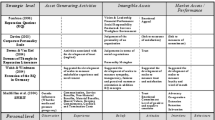Abstract
In this study, we use content analysis to measure the usefulness of the narrative content of the chairman's letter to the shareholders as a possible proxy for corporate reputation. Firms with both high and low corporate reputations are identified using three prominent rating services. Using content analysis, significant variations in word choice, word length and word variety are found between these two groups. The firms with a high corporate reputation use less varied, shorter and more concrete words than the low reputation firms. These high reputation firms concentrate on realism with a matter-of-fact type of style. Based on these variables, a logit regression successfully classifies 81 percent of our study firms according to perceived reputation. The results are further tested by matching unranked corporations to our study firms. The logit values for the matched firms are statistically different from those of the study groups. We attribute this to content differences in the letter to the shareholders. This significant association between narrative content and corporate reputation suggests that management uses the shareholders’ letter as a tool of reputation management.



Similar content being viewed by others
Notes
We do not include the awareness category because each survey requires that the survey participants be aware of the firms they are rating. Consequently, the reputation ratings would only spuriously be related to awareness.
In addition to the clarity of the statement, the letter gives verifiable statistics as to why the firm is a leading provider and why the housing industry is one of the strongest growth sectors of the economy. The combination of clarity and verifiable statements adds to perceived credibility and reputation.
We do not report these results in the paper, but they are available from the authors upon request.
References
Abrahamson, E. and Amir, E. (1996) ‘The information content of the president's letter to shareholders’, Journal of Business Finance and Accounting, 23 (8), 1157–1182.
Abrahamson, E. and Park, C. (1994) ‘Concealment of negative organizational outcomes: An agency theory perspective’, Academy of Management Journal, 37 (5), 1302–1334.
Amernic, J. and Craig, R. (2007) ‘Improving CEO-speak’, Journal of Accountancy, 203 (1), 65–66.
Barnett, M., Jermier, J. and Lafferty, B. (2006) ‘Corporate reputation: The definitional landscape’, Corporate Reputation Review, 9 (1), 26–38.
Bennett, R. and Kottasz, R. (2000) ‘Practitioner perceptions of corporate reputation: An empirical investigation’, Corporate Communications: An International Journal, 5 (4), 224–234.
Bond, G. and Lee, A. (2005) ‘Language of lies in prison: Linguistic classification of prisoners’ truthful and deceptive natural language’, Applied Cognitive Psychology, 19, 313–329.
Carpenter, R. (1986) ‘The statistical profile of language behavior with Machiavellian intent while experiencing caution and avoiding self incrimination’, Annuals of New York Academy of Sciences, 606 (1), 5–17.
Christiansen, L.T. (2002) ‘Corporate communication: The challenge of transparency’, Corporate Communications: An International Journal, 7 (3), 162–168.
Colwell, K., Hiscock, C. and Memon, A. (2002) ‘Interviewing techniques and the assessment of statement credibility’, Applied Cognitive Psychology, 16, 287–300.
Dulaney Jr., E. (1982) ‘Changes in language behavior as a function’, Human Communication Research, 9 (1), 75–82.
Greyser, S. (1999) ‘Advancing and enhancing corporate reputation’, Corporate Communications: An International Journal, 4 (4), 177–181.
Hart, R.P. (2000) DICTION 5.0 Text-Analysis User Manual, Digitext, Inc., Austin, TX, USA, pp. 32–37.
Henriksson, R.D. and Merton, R.C (1981) ‘On market timing and investment performance. An equilibrium theory of value for market forecasts’, Journal of Business, University of Chicago Press, 54 (3), 363–406.
Ingram, R.W. and Frazier, K.B. (1983) ‘Narrative disclosures in annual reports’, Journal of Business Research, 18 (2), 614–622.
Li, F. (2006) ‘Do stock market investors understand the risk sentiment of corporate annual reports?’, Working Paper, Sephen M. Ross School of Business, University of Michigan.
Michalisin, M., Karau, S. and Tangpong, C. (2004) ‘The effects of performance and team cohesion on attribution: A longitudinal simulation’, Journal of Business Research, 57, 1108–1115.
Newman, M., Berry, D. and Richards, J. (2003) ‘Lying words: Predicting deception from linguistic styles’, Personality and Social Psychology Bulletin, 29 (2), 665–675.
Roberts, P.W. and Dowling, G.R. (2002) ‘Corporate reputation and sustained superior financial performance’, Strategic Management Journal, 12, 1077–1093.
Salancik, G.R. and Meindl, J.R. (1984) ‘Corporate attributions as strategic illusions of management control’, Administrative Science Quarterly, 29, 238–254.
Smith, M. and Taffler, R. (2000) ‘The chairman's statement: Content analysis of discretionary narrative disclosures’, Accounting, Auditing & Accountability Journal, 13 (5), 624–646.
Stanwick, P. and Stanwick, S.D. (2003) ‘CEO and ethical reputation: Visionary or mercenary?’, Management Decision, 41 (10), 1050–1057.
Tennyson, M.B., Ingram, R.W. and Dugan, M.T. (1990) ‘Assessing the information content of narrative disclosures in explaining bankruptcy’, Journal of Business Finance and Accounting, 17 (3), 391–410.
Westphal, J. and Zajac, E. (1995) ‘Accounting for the explanation of CEO compensation: Substance and symbolism’, Administrative Science Quarterly, 40, 283–308.
Westphal, J. and Zajac, E. (1998) ‘The symbolic management of stockholders: Corporate governance reforms and shareholder reactions’, Administrative Science Quarterly, 43, 127–153.
Zhou, L., Twitchell, D., Qin, T., Burgoon, J. and Nunamaker Jr., J. (2002) ‘An exploratory study into deception detection in text-based computer-mediated communication’, Proceedings of the 36th Hawaii International Conference on System Sciences.
Author information
Authors and Affiliations
Rights and permissions
About this article
Cite this article
Geppert, J., Lawrence, J. Predicting Firm Reputation Through Content Analysis of Shareholders' Letter. Corp Reputation Rev 11, 285–307 (2008). https://doi.org/10.1057/crr.2008.32
Published:
Issue Date:
DOI: https://doi.org/10.1057/crr.2008.32




